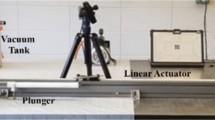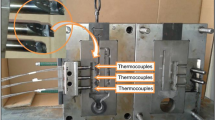Abstract
High-Pressure Die Casting (HPDC) is a near-net shape manufacturing method for the non-ferrous materials casting process, and it is widely used in the automotive industry. In the HPDC method, mold (TM) and casting temperature (TC), first- (V1) and second (V2)-phase injection velocity, injection pressure (P3), mold and casting material, mold design and vacuum application are all important parameters for producing high-quality products, as they directly affect the mechanical and metallurgical properties and micro–macroporosity of the product parts. In this study, the effects of thermal (mold and casting temperature) injection parameters and dynamic (pressure, velocity and vacuum application) injection parameters on the mechanical properties and porosity of the samples were studied. In the experiments and simulations performed as part of this study, A383 was selected as the casting material and DIN 1,2344 as the hot work tool steel. The mold cavity was shaped according to the tensile test specimen. The experiments were repeated under 64 different conditions, using different dynamic and thermal parameters and vacuum application drawn in the mold cavity. The samples obtained from the experiments were subjected to tensile tests to identify their mechanical properties. A gas pycnometer was used to measure and calculate porosity rates. All the tests were simulated using FLOW-3D software proper to the experimental conditions. In conclusion, the most useful thermal parameters obtained from the experimental study were found to be 1063 K for casting temperature and 493 K for mold temperature, while the optimum dynamic parameter values were determined to be 1.7 m/s injection velocity and 10–20 MPa injection pressure for vacuum application drawn in the mold cavity.














Similar content being viewed by others
References
X.H. Teng, Y.T. Mae, Probability characterization of tensile strength of an aluminum casting. Eng. Fract. Mech. 76, 983–996 (2009)
R.S. Beals, C. Tissington, X. Zhang, K. Kainer, J. Petrillo, M. Verbrugge, M. Pekguleryuz, Magnesium global developments Outcomes. TMS 2007 Annu. Meet. 59, 39–42 (2007)
NADCA, The North American die casting association, archived from the original on http://www.webcitation.org/5tVCFPCyL. Accessed 30 May 2016
M. Koru, Basınçlı döküm yönteminde Al-Si (A413) alaşımının termal ve dinamik parametrelere bağlı olarak ara yüzey ısı transfer katsayısının deneysel ve teorik incelenmesi, Ph.D. Thesis, Grad. Sch. of Nat. and Appl. Sci. Süleyman Demirel Üniversitesi, 127, (2009)
S.M. Dargusch, G. Dour, N. Schauer, C.M. Dinnis, G. Savage, The influence of pressure during solidification of high pressure die cast aluminium telecommunications components. J. Mater. Process. Technol. 180, 37–43 (2006)
V.D. Tsoukalas, Optimization of porosity formation in AlSi9Cu3 pressure die castings using genetic algorithm analysis. Mater. Des. 29, 2027–2033 (2008)
M. Rübner, M. Günzl, C. Körner, R.F. Singer, Aluminium–aluminium compound fabrication by high pressure die casting. Mater. Sci. Eng. A 528, 7024–7029 (2011)
M.S. Dargusch, G. Wang, N. Schauer, C.M. Dinnis, G. Savage, Manufacture of high pressure die-cast radio frequency filter bodies. Int. J. Cast Meter. Res. 18–1, 47–53 (2005)
Experimental Results, Numeric Simulation, G.O. Verran, R.P.K. Mendes, M.A. Rossi, Influence of injection parameters on defects formation in die casting Al12Si1,3Cu. J. Mater. Process. Technol. 179, 190–195 (2006)
S. Yüksel, C. Göloğlu, Metal enjeksiyon kalıplamada yolluk tasarımı sistematiği 5. Int. Adv. Technol. Symp. 8, (2009)
T.H. Imvinkelried, H. Homberger, Mould fill simulation to improve the quality of a component. Magnes. Ind. 39–43 (2001)
Ö. Savaş, R. Kayıkcı, E. Cüceloğlu, Alüminyum-Silisyum alaşımlarının dökümünde mikro porozite probleminin incelenmesi. Metal Dünyası 144, 119–123 (2005)
M.H. Marques, CAE Techniques for casting optimization. Inst. de Engenharia Mecânica e Gestão Ind. 1–4 (2006)
R. Lumley, N. Deeva, M. Gershenzon, An evaluation of quality parameters for high pressure diecasting. Int. J. Metalcasting 5(3), 37–56 (2011)
R. Lumley, N. Deeva, An evaluation of quality parameters for high pressure diecasting part II: heat treatment. Int. J. Metalcasting 5(4), 47–61 (2011)
B. Yalçın, M. Koru, A.E. Özgür, O. İpek, Effect of injection parameters and vacuum on the strength and porosity amount of die-casted A380 alloy. Int. J. Metalcasting 11(2), 195–206 (2017)
C. Thoma, W. Volk, R. Heid, K. Dilger, G. Branner, H. Eibisch, Simulation-based prediction of the fracture elongation as a failure criterion for thin-walled high-pressure die casting components. Int. J. Metalcasting 8(4), 47–54 (2014)
A.R. Adamane, L. Arnberg, E. Fiorese, G. Timelli, F. Bonollo, Influence of injection parameters on the porosity and tensile properties of high-pressure die cast Al–Si alloys: a review. Int. J. Metalcasting 9(1), 43–53 (2015)
Ö. Boydak, M. Savaş, B. Ekici, A numerical and an experimental investigation of a high-pressure die-casting aluminum alloy. Int. J. Metalcasting 10(1), 56–69 (2016)
A. Illah, N. Korti, S. Abboudi, Effects of shot sleeve filling on evolution of the free surface and solidification in the high-pressure die casting machine. Int. J. Metalcasting 11(2), 223–239 (2017)
A. Uludağ, Basınçlı döküm yönteminde kalıp sistem tasarımı ve simülasyon analizi. Msc. Thesis, Grad. Sch. of Nat. Appl. Sci., Yıldız Teknik Üniversitesi 91 (2007)
E. Flender, G. Hartman, Modeling and simulation in high pressure die casting. Met. World, 10–17 (2008)
O.S. Aslan, Basınçlı dökümde kaliteyi etkileyen faktörlerin araştırılması. Msc. Thesis, Grad. Sch. of Nat. Appl. Sci., Yıldız Teknik Üniversitesi, 84 (2007)
D. Dışpınar, F. Syvertsen, M. Ekelik, J. Campbell, Al-Si alaşımlarında kalıp dizaynı ile mekanik özellikler arasındaki ilişki. 4. Alüminyum Sempozyumu, İstanbul, 363–371 (2009)
D. Dışpınar, J. Campbell, Alüminyum ve alaşımlarının döküm kalitesinin belirlenmesi. 4. Alüminyum Sempozyumu, İstanbul, 394–404 (2009)
M. Sirviö, S. Vapalahti, J. Väinölä, Complete simulation of high pressure die casting process (Casting Simulation Web, 2007), http://www.castingsimulation.com, Available 12 August 2014
S.H.M. Anijdan, A. Bahrami, H.R. Madaah Hoseini, A. Shafyei, Using genetic algorithm and artificial neural network analyses to design an Al–Si casting alloy of minimum porosity. Mater. Des. 27, 605–609 (2006)
S.G. Lee, A.M. Gokhale, G.R. Patel, M. Evans, Effect of process parameters on porosity distributions in high-pressure die-cast AM50 Mg–allo. Mater. Sci. Eng. A 427, 99–111 (2006)
V.D. Tsoukalas, A study of porosity formation in pressure dies casting using the taguchi approach. J. Eng. Manuf. 218, 77–86 (2006)
A.K. Dahle, L. Arnberg, D. Apelian, AFS Trans. 160, 963–969 (1997)
G. Backer, M. Ranganathan, J. Heimsch, M. Mclaughlin, W. Kim, Simulation of flow-induced gas entrapment and its effects on porosity in aluminum die castings. North Am. Die Cast. Assoc. Trans. 44–53 (2001)
C.K. Jin, C.G. Kang, Fabrication by vacuum die casting and simulation of aluminum bipolar plates with micro-channels on both sides for proton exchange membrane (PEM) fuel cells. Int. J. Hydrogr. Energy 32, 1661–1676 (2012)
C.K. Jin, C.G. Kang, Fabrication process analysis and exprimental verification for aluminum bipolar plates in fuel cells by vacuum die-casting. J. Power Sour 196, 8241–8249 (2011)
S. Li, D. Li, X. Zeng, W. Ding, Microstructure and mechanical properties of Mg–6Gd–3Y–0.5Zr alloy processed by high-vacuum die-casting. Trans. Nonferrrous Met. Soc. China 24, 3769–3776 (2014)
Q. Wang, S. Xiong, Vacuum assisted high-pressure die casting of AZ91D magnesium alloy at different slow shot speeds. Trans. Nonferrous Met. Soc. China 24, 3051–3059 (2014)
H.H. Doehler, Basınçlı Döküm, (Bayvas, M. Ş., Mesleki ve Teknik Öğretim Kitapları, Etüd Programlama Dairesi Yayınları No: 80), p. 514
D.M. Stefanescu, ASM Handbook Volume 15: Casting, 1st edn. (ASM International, 1988), p. 1256
K. Obiekea, S.Y. Aku, D.S. Yawas, Influence of pressure on the mechanical properties and grain refinement of die cast aluminum A1350 alloy. Adv. Appl. Sci. Res. 3, 6 (2012)
J. Weiler, J. Wood, R. Klassen, E. Maire, R. Berkmortel, G. Wang, Relationship between internal porosity and fracture strength of die-cast magnesium AM60B alloy. Mater. Sci. Eng. A 395, 1–2 (2005)
C.D. Lee, K.S. Shin, Effect of microporosity on the tensile properties of AZ91 magnesium alloy. Acta Mater. 55(13), 4293–4303 (2007)
Acknowledgements
We would like to thank the Scientific and Technological Research Council of Turkey (TÜBİTAK) for supporting this project with the project number 114M003 and Süleyman Demirel University BAP Coordination Unit for supporting the Project with Number 4416-YL1-15.
Author information
Authors and Affiliations
Corresponding author
Rights and permissions
About this article
Cite this article
Koru, M., Serçe, O. The Effects of Thermal and Dynamical Parameters and Vacuum Application on Porosity in High-Pressure Die Casting of A383 Al-Alloy. Inter Metalcast 12, 797–813 (2018). https://doi.org/10.1007/s40962-018-0214-7
Published:
Issue Date:
DOI: https://doi.org/10.1007/s40962-018-0214-7




